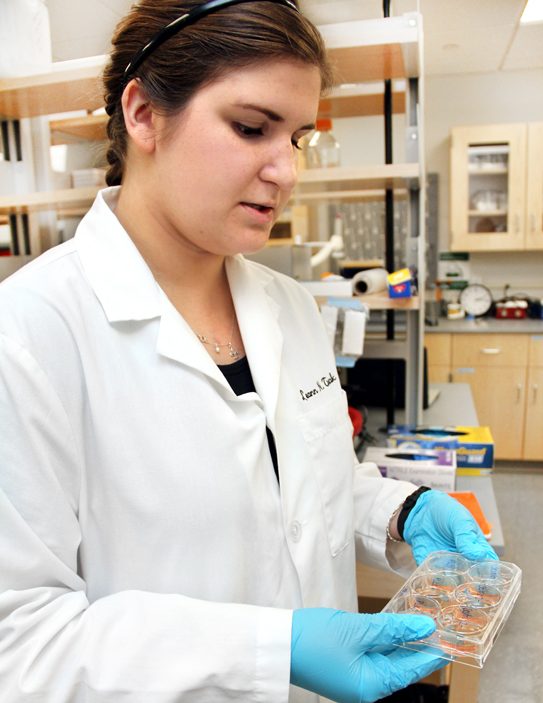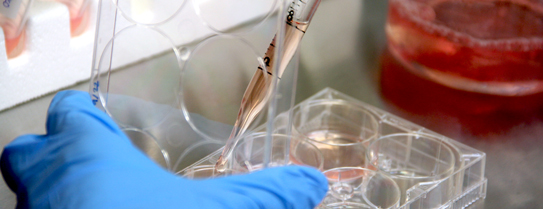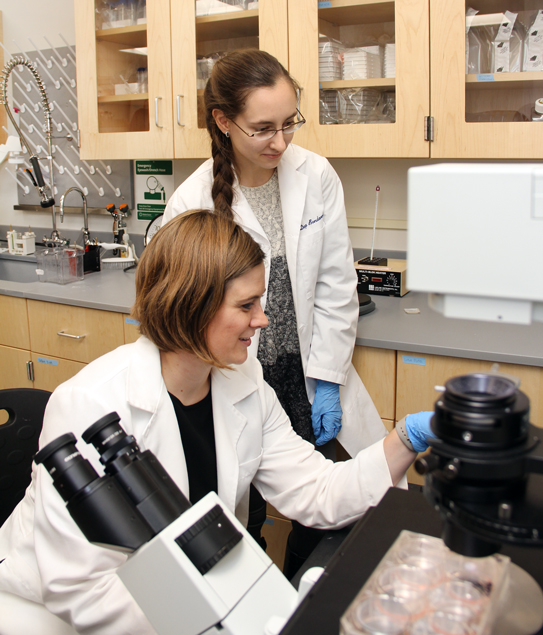Cancer Research at Saint Mary's
Up on the third floor of our Science Hall, three students quietly conduct ovarian cancer research using state-of-the-art equipment. Dressed appropriately in white lab coats, they manipulate and closely examine colorful petri dishes that look like something from a CSI episode. Each one contains stained ovarian cancer cells that might hold answers on how to better fight cancer.
 The students, Leann Tulisiak ’18, Irma Ruelas ’18, and Darya Bondarenko ’18 are part of a group working with Biology Professor Calli Davison Versagli ‘09. Versagli got her start in cancer research at Notre Dame. She was just beginning her doctorate when she learned of a breast cancer research project and was motivated by a personal experience to give it a try. “I was immediately hooked and knew this was where I was meant to be,” she shared. But as the research continued she began to question her ability to make a real impact. “We already have a solid method of detection and treatment for breast cancer.” Versagli explains, “But ovarian…that’s a whole other story.”
The students, Leann Tulisiak ’18, Irma Ruelas ’18, and Darya Bondarenko ’18 are part of a group working with Biology Professor Calli Davison Versagli ‘09. Versagli got her start in cancer research at Notre Dame. She was just beginning her doctorate when she learned of a breast cancer research project and was motivated by a personal experience to give it a try. “I was immediately hooked and knew this was where I was meant to be,” she shared. But as the research continued she began to question her ability to make a real impact. “We already have a solid method of detection and treatment for breast cancer.” Versagli explains, “But ovarian…that’s a whole other story.”
For Versagli, making a difference matters. It’s why she decided to start researching ovarian cancer and why she decided to work at Saint Mary’s. “I knew we either have to get better at detecting ovarian cancer or better at treating late stage cancer. And that is a place I might be able to help.”
For women, ovarian is the number five cancer killer primarily because only about 20 percent of the cases are diagnosed at an early stage. For those few that are identified when it is localized to the ovaries, survival past five years is an optimistic 94 percent. But for the majority, the disease is detected at a later stage after it has metastasized to other locations. As a result, treatment options are often dramatically reduced and survival is not nearly as high.
Understanding how it spreads
Cancer cells have a unique ability. Simply put, they live and spread in environments in which other cells would not survive. Cells that make up our intestines live only as intestines, for example, and those that make up our liver don’t suddenly spread to our knees. So how does an ovarian cancer cell survive the trip to the stomach and take up residence there?
This migration, or metastasis, is a defined “hallmark of cancer” but is also one of the big mysteries. And once cancer cells spread to another part of the body from the original host locale, the disease automatically receives the dreaded Stage IV classification.
So Versagli and her research students are exploring conditions that make metastasis possible in hopes to find ways to impede the growth and progress of the disease. Imagine a day where cancer cells could be stopped from spreading to the bloodstream and other organs. This advancement would give pharmaceutical companies and physicians a significant opportunity to treat, cure, and eventually eliminate cancer.
 Cutting edge research
Cutting edge research
Using tools such as a fluorescence microscope, Versagli and her students are able to examine the actual molecular mechanism that helps cancer cells complete what is called “the metastatic cascade.” Put another way, this $100,000 piece of lab equipment not only elevates the students’ research experience but gives them a clear look into how cancer grows and spreads. It’s not something most undergraduate students get to experience. Referencing both the capabilities of the lab and the students’ experience, Versagli stated, “It would be great to build on this. My goal is to help develop these women and I’d love to make Saint Mary’s a hub for women in medical research.”
Which is where Versagli works to make another impact. As a graduate of both Saint Mary’s and Notre Dame, she could be conducting her research just about anywhere but she chose to return here. When asked why, Calli explained, “I benefited from the process of being a Saint Mary’s student and honestly, I wanted to give back.”
 As a professor of biology, often working with pre-med students the guidance and insights she provides is readily evident. Even a bystander can see the how the students gain from her leadership which comes across in a calm and supportive manner. Most of all you can tell she has a true interest in her research and her students. She discussed the obvious intellectual ability and passion of both students and colleagues and summed up her thoughts on her alma mater, saying simply, “Saint Mary’s is such a special place.”
As a professor of biology, often working with pre-med students the guidance and insights she provides is readily evident. Even a bystander can see the how the students gain from her leadership which comes across in a calm and supportive manner. Most of all you can tell she has a true interest in her research and her students. She discussed the obvious intellectual ability and passion of both students and colleagues and summed up her thoughts on her alma mater, saying simply, “Saint Mary’s is such a special place.”
It is indeed a special place and perhaps one day, under Versagli’s tutelage, Saint Mary’s will deliver a beautiful finding to help combat such an ugly disease.

Article reprinted from Courier, Fall/Winter 2017. See other great articles or download full issues online at saintmarys.edu/courier.
